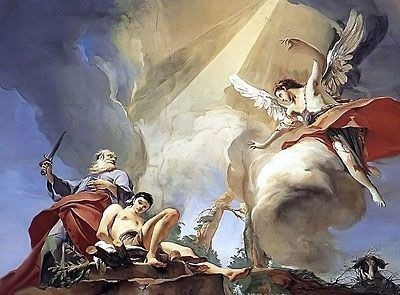Free |
GIOVANNI BATTISTA TIEPOLO | ||
Giovanni Battista Tiepolo gallery of high resolution images of his famous biblical paintings, royalty free. Art and Artist study of his famous Bible paintings. Always Royalty Free |
Tiepolo 1696 – 1770 The last great name in the illustrious roll of Venetian masters was Giovanni Battista Tiepolo, who was born in Venice, in 1696, and died in Madrid, in 1770. His father, a ship captain and merchant of marine goods, left him a considerable estate and he seems never to have experienced the vicissitudes that attend the average artist. The sources of his early inspiration were Titian and Paulo especially the latter, whom, however, he excelled as a ceiling decorator, in which field he has never had a rival. The amount of wall space he covered with his magnificent frescos is nothing short of stupendous, besides altar pieces, etchings and finished sketches for many of his works. His ceiling frescos, where the subject is a secular one, show the same striking arrangement of masses as do his religious compositions. Tiepolo nearly always introduces a four-horse chariot in them, the spirited horses rearing and careering across the vaults of the sky, showing his marvelous powers of foreshortening. Although many of his finest frescos are to be found in the churches of his native city, Tiepolo spent many years outside of Italy engaged upon commissions for foreign potentates. The last great honor paid him was to be called to Spain to decorate the Royal Palace in Madrid for Charles III, who had lately ascended the throne. Accompanied by his two sons and his model, Christina, he established a residence in the Spanish capital in 1762, being allowed, in addition to the expenses of the journey, 2000 rubles of gold a year and 500 ducats for a carriage. Immediately upon his arrival at Madrid his health began to fail, and he made his will and deposited it with the royal notary. He lived eight years longer, however, superintending vast works for the Royal Palace, and is said to have incurred the jealousy and hatred of Raphael Mengs, who had been Court Painter under the preceding monarch. No account of Tiepolo would be complete without mention of the two models who appear so frequently in his pictures. Most important was the aforementioned Christina, daughter of a Venetian gondolier, who accompanied the artist to Spain and appears to have been a member of his household. In fact, we read, Tiepolo never used any other female model, and her image is to be found alike in the altar-piece and on the vault of ducal palaces. She appears now as a saint, now as an historical character, or again as a mythological personage. Tiepolo's other model was a Moorish slave who was brought to Venice as a Corsair prisoner. The artist bought him, instructed him in the Christian religion, to which he became a convert, and used him as a model. Tiepolo seems to have amassed a considerable fortune. Of his gambling wife, who does not appear to have accompanied him on his travels, an anecdote is told of how one evening, having lost all the money she had brought with her, she rose to go, when her opponent volunteered to play for the sketches in her husband's studio. She played again, and lost. Again her wily opponent offered to play for her country villa at Zianigo. A third time she lost; but fortunately her businesslike son, who was absent from Venice at the time, returned home in time to cancel her debt, but not without disposing of a large number of sketches by the absent master. Navigation and Searching – Terms of Use – Contact Us |
